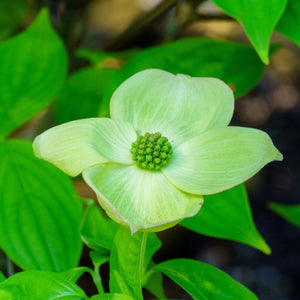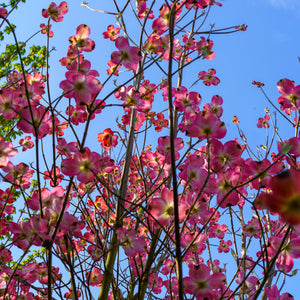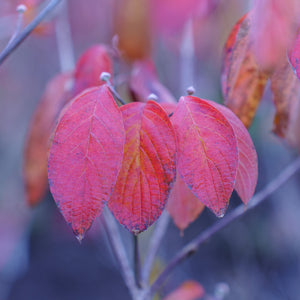The Dogwood Guide
Dogwood trees (Cornus spp.) are some of the most beloved ornamental trees in American gardens, prized for their showy spring flowers, graceful branching, and vibrant fall foliage. Native to North America and Asia, these versatile trees offer year-round interest, with attractive bark, seasonal color, and even ornamental fruit in some varieties. Whether you're planting in a woodland setting or an urban landscape, dogwoods make an elegant and timeless focal point.
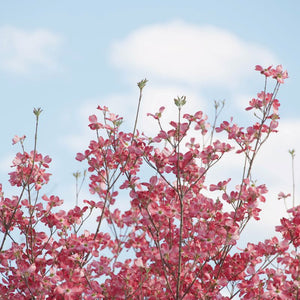
About
The Cornus genus encompasses a range of species, including Cornus florida (Flowering Dogwood), Cornus kousa (Kousa Dogwood), Cornus mas (Cornelian Cherry), and Cornus racemosa (Gray Dogwood). Each offers distinct ornamental value, bloom time, and growth habit.
Cornus florida cultivars like 'Appalachian Spring', 'Cherokee Chief', and 'Cloud 9' are native to the Eastern U.S. and are known for large, bracted white or pink blooms in early spring. Cornus kousa selections, such as 'Summer Gold', 'Wolf Eyes', and 'Rosy Teacups', flower slightly later and boast pointed petals with upright branching and excellent disease resistance. Hybrid varieties, such as Cornus x rutgersensis 'Celestial Shadow' and Cornus x 'Rutdan' (Aurora), combine the best traits of both.
Cornus mas (Cornelian Cherry) blooms very early in spring with clusters of small yellow flowers and produces small edible fruits later in the season. Cornus racemosa, a native shrub-like species, offers white flower clusters followed by red stems in winter, providing multi-season appeal.
With ornamental value spanning multiple seasons, dogwoods make excellent understory trees and can serve as both focal points and supporting elements in layered landscape designs.
PLANTING
Planting a dogwood properly sets the stage for long-term success. These trees prefer well-drained soil and consistent moisture but are adaptable to various garden conditions.
USDA Hardiness Zones: Most dogwoods thrive in Zones 5–8. Cornus kousa and Cornus mas tend to be more cold-hardy, while Cornus florida prefers milder climates with some humidity.
Soil: Rich, well-drained, slightly acidic soils are ideal. Incorporate compost or organic matter at planting time.
Sunlight: Part shade to full sun. Cornus florida benefits from afternoon shade in hot climates. Cornus kousa tolerates more sun, especially in northern zones.
Watering: Water deeply and consistently during establishment (first 1–2 years). Mature dogwoods tolerate occasional drought but perform best with regular moisture.
Spacing: Depending on the variety, space trees 15–25 feet apart. Dwarf forms like Cornus kousa 'Little Poncho' may be spaced more tightly.
Planting Time: Early spring or fall is ideal. Avoid planting during high summer heat or when soil is saturated.
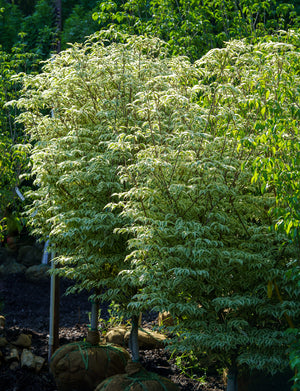
CARE
Dogwoods require relatively low maintenance but benefit from seasonal care to ensure vigorous growth and abundant flowering.
- Watering: Maintain moderate, consistent soil moisture. Avoid waterlogging, which may promote disease.
- Fertilizing: Apply a slow-release, balanced fertilizer in early spring. Avoid over-fertilizing, especially with high nitrogen blends.
- Pruning: Prune for structure and shape in late winter or just after flowering. Remove any dead, diseased, or crossing branches.
- Mulching: Use a 2-3 inch layer of mulch to retain moisture and suppress weeds. Keep mulch a few inches away from the trunk.
- Pests & Diseases: Watch for dogwood anthracnose, especially on Cornus florida. Cornus kousa and hybrids show better resistance. Common pests include dogwood borer and scale.
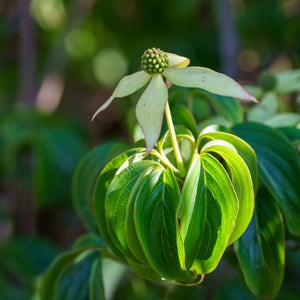
HOW TO USE
Dogwoods are one of the most versatile small trees for landscape design. Their seasonal beauty, manageable size, and natural form allow them to complement a wide range of garden settings.
- Focal Points: Upright forms like Cornus florida 'Appalachian Spring' or weeping selections like Cornus kousa 'Kristin Lipka's Variegated Weeper' create eye-catching focal points in front yards or near patios.
- Woodland Gardens: Native dogwoods like Cornus florida and Cornus racemosa are perfect for shady woodland gardens alongside ferns, hellebores, and heuchera.
- Foundation Plantings: Dwarf and compact cultivars such as Cornus kousa 'Little Poncho' fit nicely into foundation beds.
- Mixed Borders: Combine with spring bulbs, azaleas, and rhododendrons for a layered effect.
- Pollinator Gardens: The flowers attract bees and butterflies, while the fruits feed birds in late summer.
Dogwood's graceful form, spring blooms, and vibrant fall color make it an ideal focal point for four-season interest.
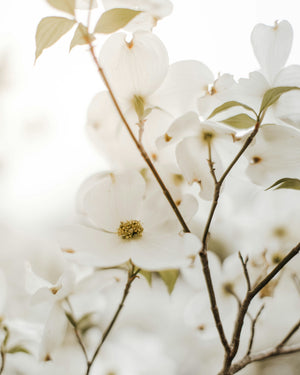
Common Questions
When do dogwoods bloom? Cornus florida blooms in early spring, while Cornus kousa follows in late spring to early summer. Cornus mas is among the earliest bloomers, often flowering in late winter.
How big do dogwood trees get? Size depends on species and cultivar. Most range from 15 to 30 feet tall and wide. Dwarf varieties stay under 10 feet.
How to plant a dogwood? Dig a hole 2–3 times wider than the root ball, plant at the same depth as it was in the pot, and backfill with a mix of native soil and compost.
What do dogwood trees look like? Dogwoods have elegant branching, oval green leaves that turn red or purple in fall, and either white, pink, or yellow flower bracts, depending on species.
When to prune dogwood trees? Light pruning should be done after flowering or in late winter. Avoid heavy pruning during active growth.
How fast do dogwood trees grow? Dogwoods are moderate growers, adding about 1–2 feet per year once established.
Do deer eat dogwood trees? Dogwoods are moderately deer-resistant, especially Cornus kousa. However, young trees may still be browsed in areas with heavy deer pressure.
When to cut back dogwood trees? Prune in late winter to early spring before new growth starts, or just after flowering to shape the tree.
Conclusion
Dogwood trees are a cornerstone of ornamental landscaping, offering beauty and function throughout the year. With selections like Cornus florida 'Cherokee Princess', Cornus kousa 'Summer Gold', and hybrids such as Cornus x 'Rutdan', there is a dogwood for every garden. Their ability to act as a focal point, support pollinators, and adapt to various conditions makes them a timeless choice for both traditional and modern landscapes.
The Dogwood Collection
Sold Out
Sold Out
Sold Out
Sold Out
Sold Out


